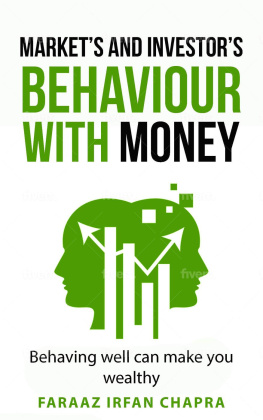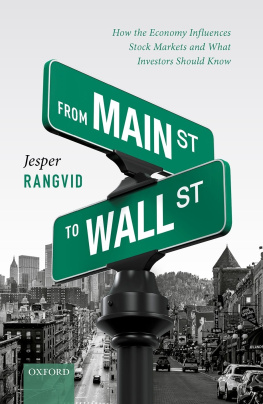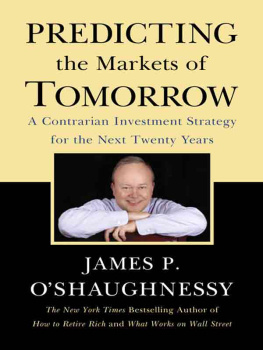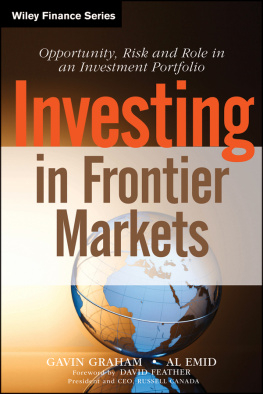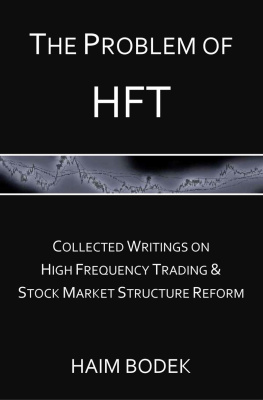Broken Markets
How High Frequency Trading and
Predatory Practices on Wall Street
Are Destroying Investor Confidence and
Your Portfolio
Sal Arnuk
Joseph Saluzzi
Vice President, Publisher: Tim Moore
Associate Publisher and Director of Marketing: Amy Neidlinger
Executive Editor: Jim Boyd
Operations Specialist: Jodi Kemper
Assistant Marketing Manager: Megan Graue
Cover Designer: Chuti Prasertsith
Managing Editor: Kristy Hart
Project Editor: Jovana San Nicolas-Shirley
Copy Editor: Apostrophe Editing Services
Proofreader: Gill Editorial Services
Indexer: Lisa Stumpf
Senior Compositor: Gloria Schurick
Manufacturing Buyer: Dan Uhrig
2012 by Sal Arnuk and Joseph Saluzzi
Publishing as FT Press
Upper Saddle River, New Jersey 07458
This book is sold with the understanding that neither the authors nor the publisher is engaged in rendering legal, accounting, or other professional services or advice by publishing this book. Each individual situation is unique. Thus, if legal or financial advice or other expert assistance is required in a specific situation, the services of a competent professional should be sought to ensure that the situation has been evaluated carefully and appropriately. The authors and the publisher disclaim any liability, loss, or risk resulting directly or indirectly, from the use or application of any of the contents of this book.
FT Press offers excellent discounts on this book when ordered in quantity for bulk purchases or special sales. For more information, please contact U.S. Corporate and Government Sales, 1-800-382-3419, .
Company and product names mentioned herein are the trademarks or registered trademarks of their respective owners.
All rights reserved. No part of this book may be reproduced, in any form or by any means, without permission in writing from the publisher.
Printed in the United States of America
First Printing May 2012
ISBN-10: 0-13-287524-1
ISBN-13: 978-0-13-287524-0
Pearson Education LTD.
Pearson Education Australia PTY, Limited.
Pearson Education Singapore, Pte. Ltd.
Pearson Education Asia, Ltd.
Pearson Education Canada, Ltd.
Pearson Educatin de Mexico, S.A. de C.V.
Pearson EducationJapan
Pearson Education Malaysia, Pte. Ltd.
The Library of Congress cataloging-in-publication data is on file.
We dedicate this book to the executives at the
major U.S. stock exchanges, to high frequency
trading firms, to lobbyists, and to numerous other
conflicted parties in Washington, D.C., and Wall
Street. Without your actions, we would never have
become outraged enough to write this book.
Foreword
by Former U.S. Senator Ted Kaufman
I didnt know a great deal about high frequency trading and the negative effect it was having on the financial markets and the economy when I became a United States Senator early in 2009, taking the seat vacated by Vice President-elect Joe Biden. But thanks to Sal Arnuk and Joseph Saluzzi of Themis Trading, I learned quickly.
During the Bush II administration, I became concerned about changes in the rules on short selling. Along with Republican Senator Johnny Isaakson, I wrote to SEC Chair Mary Schapiro, asking her to follow up on her confirmation hearing pledge to look into reinstating the uptick rule, which had been removed in what former SEC Chair Chris Cox admitted had been a mistake. Short sellers play an important role in maintaining an orderly market. But there also are predatory bears. If not policed, they could have a devastating effect by creating a never-ending, negative feedback loop. The uptick rule helped to prevent that by prohibiting the shorting of a security unless the most recent trade was an increase in price.
As it turned out, I lost the battle to reinstate the rule. The main force pushing back was a new group on Wall Street called high frequency traders (HFT). Intrigued, I began to look into what HFT was all about.
One of the great things about being a United States Senator is the access you to have to experts willing to educate you on issues. While my staff and I met with a number of people who claimed to know a lot about HFT, I quickly learned that the ones who made the most sense and had the best take on what was happening were Sal and Joe. They founded Themis Trading and are experts in equity trading on behalf of institutional customers, such as mutual and pension funds. They quickly gave me and my staff an education on HFT that was the best I had heard.
After we talked to Sal and Joe and others and deeply studied the issue, I wrote to SEC Chair Schapiro in August 2009, outlining my concerns about the present market structure and HFT. I spoke many times in the next year on the Senate floor about the dramatic changes taking place in our equity markets, explaining obscure practices like colocation, naked access, flash orders, and the proliferation of dark pools. But mostly I spoke about the explosion in HFT, which had come to dominate the equity markets and account for well more than half of all daily trading volume.
My message was straightforward: The technological advances and mathematical algorithms that have allowed computers to trade stocks in millionths of a second in and of themselves are neither good nor bad. Indeed, as an engineer, I have a deep appreciation for technological progress. But technology cannot operate in a vacuum, and it should not dictate how our markets function. Simply put, technology must operate within a framework that ensures integrity and fairness.
That is why our regulatory agencies are so critically important. While technology often produces benefits, it also can introduce conflicts that pit long-term retail and institutional investors against professional traders who are in and out of the market many times a day. As Chair Schapiro has consistently asserted, including in a letter to me more than two years ago, If...the interests of long-term investors and professional traders conflict...the Commissions focus must be on the protection of long-term investors.
Many people have asked me why I focused so intently on the arcane details of how stocks are traded. There are several reasons.
First, we must not just look backward and analyze the factors that brought about the last financial crisis. We must also be proactive and identify brewing problems before they create a new crisis.
Second, we have to protect the credibility of our markets. The two great pillars upon which America rests are democracy and our capital markets. But there is more at stake than a structural risk that could bring our markets once again to their knees, as occurred on May 6, 2010, during the Flash Crash. There is a real perceptual risk that retail investors will no longer believe that the markets are operating fairly, that there is simply not a level playing field. If investors dont believe the markets are fair, they wont invest in them. And if that happens, we can all agree our economy will be in serious trouble.
Third, we should have learned the lesson from derivatives trading. When we have opaque markets, disaster is often not far behind. It is hardly surprising that high frequency trading deserves a watchful, and possibly critical, government eye. It is simply a truism that whenever there is a lot of money surging into a risky area, where change in the market is dramatic, where there is no transparency and therefore no effective regulation, we have a prescription for disaster. We had a disaster in the fall of 2008, when the credit markets suddenly dried up and our markets collapsed. The Flash Crash was a near-disaster.
The SEC continues to study the causes for the Flash Crash. I hope the agency has moved much closer to truly understanding the dramatic changes in market structure that have taken place in the past few years, the potential ramifications of HFT, and its impact on retail and institutional investors.


